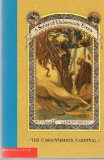Summary | Excerpt | Reading Guide | Reviews | Readalikes | Genres & Themes | Author Bio

Book the Ninth (A Series of Unfortunate Events)
by Lemony Snicket, Brett HelquistChapter One
When my workday is over, and I have closed my notebook, hidden my pen, and
sawed holes in my rented canoe so that it cannot be found, I often like to spend
the evening in conversation with my few surviving friends. Sometimes we discuss
literature. Sometimes we discuss the people who are trying to destroy us, and if
there is any hope of escaping from them. And sometimes we discuss frightening
and troublesome animals that might be nearby, and this topic always leads to
much disagreement over which part of a frightening and troublesome beast is the
most frightening and troublesome. Some say the teeth of the beast, because teeth
are used for eating children, and often their parents, and gnawing their bones.
Some say the claws of the beast, because claws are used for ripping things to
shreds. And some say the hair of the beast, because hair can make allergic
people sneeze.
But I always insist that the most frightening part of any beast is its belly,
for the simple reason that if you are seeing the belly of the beast it means you
have already seen the teeth of the beast and the claws of the beast and even the
hair of the beast, and now you are trapped and there is probably no hope for
you. For this reason, the phrase 'in the belly of the beast' has become an
expression which means 'inside some terrible place with little chance of
escaping safely,' and it is not an expression one should look forward to using.
I'm sorry to tell you that you can lean back against the upholstery, look out
the window at the scenery going by, and feel safe and secure with a seat belt
fastened low and tight across your lap. But the Baudelaires could not lean back,
and their bodies were aching from squishing up against one another for several
hours. They had no window to look out of, only a few bullet holes in the trunk
made from some violent encounter I have not found the courage to research. And
they felt anything but safe and secure as they thought about the other
passengers in the car, and tried to imagine where they were going.
The driver of the automobile was a man named Count Olaf, a wicked person with
one eyebrow instead of two and a greedy desire for money instead of respect for
other people. The Baudelaires had first met Count Olaf after receiving the news
that their parents had been killed in a terrible fire, and had soon discovered
he was only interested in the enormous fortune their mother and father had left
behind. With unceasing determination -- a phrase which here means 'no matter
where the three children went' -- Count Olaf had pursued them, trying one
dastardly technique after another to get his hands on their fortune. So far he
had been unsuccessful, although he'd had plenty of help from his girlfriend, Esmé
Squalor -- an equally wicked, if more fashionable, person who was now sitting
beside him in the front seat of the automobile -- and an assortment of
assistants, including a bald man with an enormous nose, two women who liked to
wear white powder all over their faces, and a nasty man who had hooks instead of
hands. All of these people were sitting in the back of the automobile, where the
children could sometimes hear them speaking over the roar of the engine and the
sounds of the road.
One would think, with such a wretched crew as traveling companions, that the
Baudelaire siblings would have found some other way to travel rather than
sneaking into the trunk, but the three children had been fleeing from
circumstances even more frightening and dangerous than Olaf and his assistants
and there had been no time to be choosy. But as their journey wore on, Violet,
Klaus, and Sunny grew more and more worried about their situation. The sunlight
coming in through the bullet holes faded to evening, and the road beneath them
turned bumpy and rough, and the Baudelaire orphans tried to imagine where it was
they were going and what would happen when they got there.
Text copyright 2002 by Lemony Snicket. Illustrations copyright 2002 by Brett Helquist. All rights reserved. Not to be used or reproduced in any matter whatsoever without written permission.




A book may be compared to your neighbor...
Click Here to find out who said this, as well as discovering other famous literary quotes!
Your guide toexceptional books
BookBrowse seeks out and recommends the best in contemporary fiction and nonfiction—books that not only engage and entertain but also deepen our understanding of ourselves and the world around us.